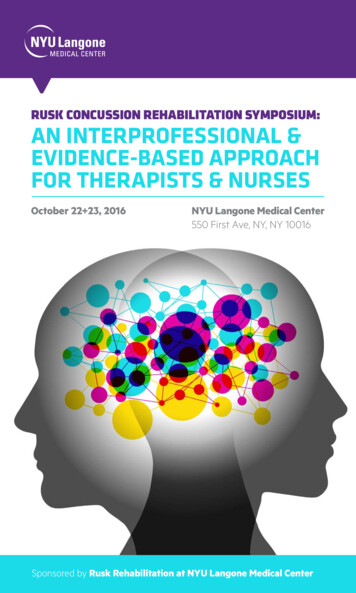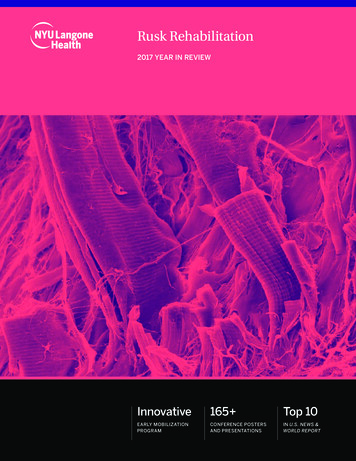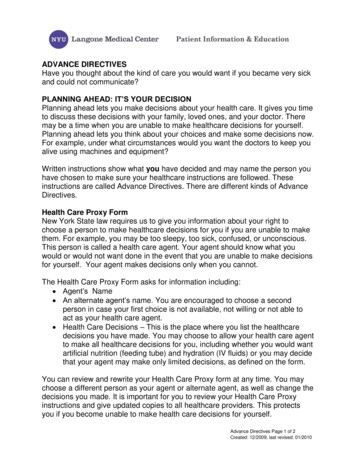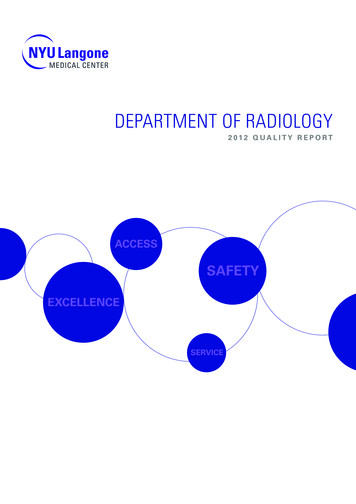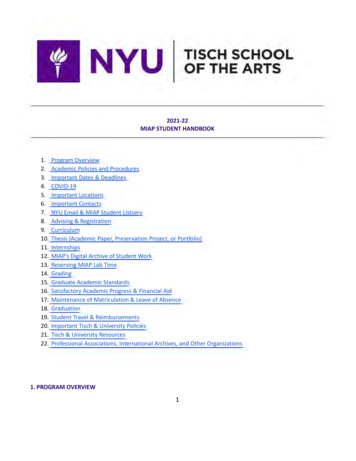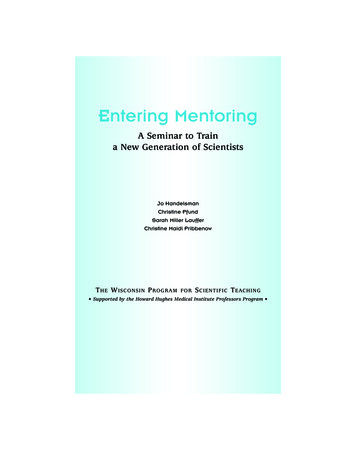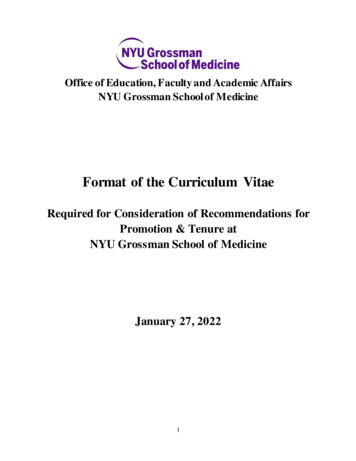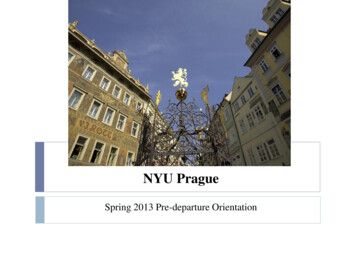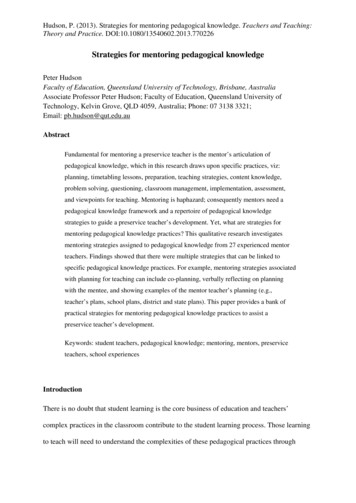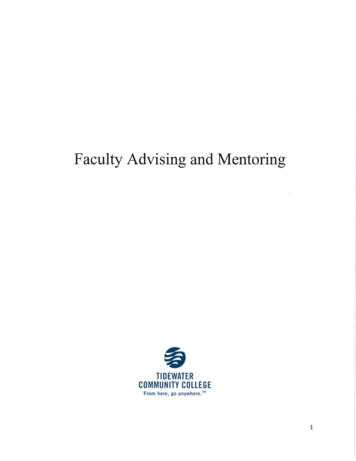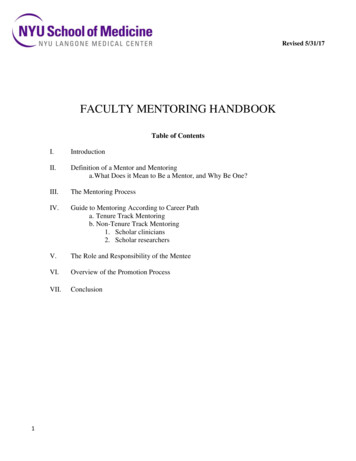
Transcription
Revised 5/31/17FACULTY MENTORING HANDBOOKTable of Contents1I.IntroductionII.Definition of a Mentor and Mentoringa. What Does it Mean to Be a Mentor, and Why Be One?III.The Mentoring ProcessIV.Guide to Mentoring According to Career Patha. Tenure Track Mentoringb. Non-Tenure Track Mentoring1. Scholar clinicians2. Scholar researchersV.The Role and Responsibility of the MenteeVI.Overview of the Promotion ProcessVII.Conclusion
I.IntroductionThis handbook is intended to describe the mentoring programs for NYULMC faculty, outlines theresponsibilities and roles of departments, departmental Mentoring Champions, mentors, and mentees,and provides suggestions and guidance for mentoring. Accordingly, the focus will be on topics pertinentto directing and encouraging the professional development and academic success of junior facultyfollowing various career paths.Mentoring programs positively impact individual faculty members, their departments, and theinstitution. Mentoring enhances the institution’s ability to recruit and to retain promising faculty, and tocreate a nurturing and healthy environment for work and growth. Accelerated development of juniorfaculty can mobilize resources to meet departmental and institutional needs in the arenas of clinicalservice, education, research, administration, and leadership succession. Strong and successful mentoringtranslates into increased individual job satisfaction, a constructive atmosphere in the workplace,improved performance and productivity, and sustained professional vitality. Faculty mentoring isintegral to being a world class institution; by providing individualized roadmaps to achievement andprofessional growth mentoring promotes the success of the institution at large.NYULMC is committed to providing prescribed mentoring for its junior and mid-career faculty, and istherefore equally committed to aiding the development of a cadre of talented mentors. We hope thishandbook will guide and promote participation in all roles in the mentoring process.2
Goals and Responsibilities by RoleRoleDeansChairGoals1. Widespread effective facultymentoring2. Accountability in mentoring metrics3. Faculty development and satisfaction3. Enforce accountability2. Engaged faculty, with heightenedcareer satisfaction3. Ensure quality & effectiveness of mentoring3. Faculty development4. Support & acknowledge faculty who providementoring1.Support the chair, as designee, tooversee effective faculty mentoringand development programs1. Liaise with the OMFD to design, implement, &manage a departmental mentoring program2. Ensure mentoring teams form & meet2. Regularly meet with mentors3. Disseminate mentoring and professionaldevelopment information to the department1. Support and guide junior facultycareer advancement1. Availability and expertise2. Promote professional satisfaction3. Provide honest, meaningful feedback3. Foster each mentee’s strengths andunique potential4. Documentation of progress through an Annual1. Identification and demarcation ofcareer pathway2. Delineation of necessary steps,activities and milestones to attaingoal3. Access to expert advice inestablishing priorities and focus32. Mandate support and involvement of chairs1. Support and work with the departmental MentoringChampion3. Development of a cadre of engagedeffective mentorsMentee1. Provide structure and support for programimplementation1. Mentoring for all tenure eligible,mandated junior scholar track faculty,and other interested facultyMentoring2. Effective & valuable mentoring for allChampionrequired & interested junior facultyMentorResponsibilities2. Provide valuable information and guidanceMentoring Letter1. Keep mentor(s) apprised of progress2. Proactively arrange appropriately paced interactions3. Meet goals and adhere to time lines4. Accept and internalize feedback
II. Definition of a Mentor and Mentoring:What Does It Mean to be a Mentor, and Why Be One?The definition of a ‘mentor’ is a trusted counselor or guide. To mentor a junior colleague is to becomeinvolved in, and provide guidance for, the decisions that will impact on the mentee’s professionaldevelopment and career advancement. In addition to providing support, the mentor may ultimatelyassume some responsibility for the mentee’s success and failure. In the broadest sense mentors helpjunior faculty adopt academic values and manage an academic career. The type of guidance inprofessional activities typically offered may include defining, narrowing, or expanding a career path,helping to establish professional liaisons, delineating research focus or a clinical niche, supportinggrowth as an educator, advice on procuring funding, accessing professional development resources,shepherding through the promotion and tenure process, and exploring career avenues such as inadministration, education, etc.TOP 10 CHARACTERISTICS OF A MENTORAble to provide support and counselMotivatorAccess to professional networksObjectiveResponsiveOrganizedAvailable and accessibleMediator / Political savvyRole modelLiberal with feedbackGoals of Mentoring:Successful mentoring is:a. Defined by the steady, timely progress of the mentee either as a researcher, clinician-scientist,clinician, educator, or administrator.b. Gauged by scholarly output, academic promotion, leadership positions, tenure and/or othermilestones as determined by the specific career choice of the mentee.c. Recognized by satisfied, fulfilled participants.d. Results in productive faculty who have found their appropriate roles and career paths.e. Measured by the attraction and retention of top faculty to the institution.Why Be a Mentor?a. Much gratification can be gained from the success of those you influence. The success of thejunior person reflects on the mentor.b. Mentoring is an important contribution to the department and the institution.i. A belief in the cause and a conviction in the power of mentoring to strengthen thefaculty and to advance the mission of the department and institution is a strong incentiveto mentor.c. It is an expectation of your Chair.i. Appropriate acknowledgement of your time, effort and expertise should be assured.4
d. Mentoring allows you to influence the future of your field. Your ideals, your professionalgenerosity, your ethics, your values, are imparted to each of your mentees and through them tosubsequent generations.III. 5The Mentoring ProcessEstablish the Mentoring TeamsThe first step is creation of mentoring teams by the Mentoring Champion, in consultation withtheir chair.Creating enduring and valuable mentoring pairings may require an understanding of what thementee seeks from the program and the mentor. This can be achieved by utilizing a brief facultysurvey, which is available in the Faculty Mentoring Toolbox, on the Office of Mentoring andFaculty Development website.Sometimes it is more important that the mentor and mentee have compatible styles than that theywork in the same area. Incongruence in approaches (in life and work) may frustrate both parties.On the other hand, occasionally incongruent approaches provide a good balance, againpotentially benefitting both parties. There is an element of ‘chemistry’ here.Congruence in values should be considered. For example, a driven ‘workaholic’ should not bepaired with someone whose obligations and interests outside of work will result in frustrations;again, this could refer to either party.‘Layered mentoring’, with mentors of divergent strengths and expertise, is very effective.Maintaining a degree of separation between mentoring committees and chairs is desirable, as itencourages unconstrained dialog between the committee and mentee; chairs should not serve onmentoring committees.Similarly, ideally the mentoring committee should not include the direct research supervisor inmost cases.Establish the Mentor/ Mentee RelationshipMentoring, a highly interactive process requires strong bilateral commitment to the effort.Attention should be paid to establishing the relationship on the right note.Initial contact should establish the style and logistics of meetingso Structured scheduled meetings as opposed to impromptu or casual discussion. This willdepend in part on the size of your department or division and the frequency with whichyour paths crosso One-on-one meetings as opposed to ‘team’ meetings of the mentee and more than onementor.o Agree on the frequency of meetings—this can change during the course of one’s career,depending on the stage and ongoing professional activities.Establishing the nature of the relationship may be intuitive and may evolve over time. Somementoring relationships are purely professional; some include social and personal aspects.o While the relationship is established in a professional setting it is appropriate toincorporate discussions of home life and achieving balance in one’s life and career. Youshould know whether your mentee is married or has a partner, has children, what theyenjoy doing in their leisure time, etc.o Some mentors are more role models than senior sages. Through demonstratedcompetence in dealing with the challenges of the career pathway, and proven ability tonavigate the terrain, at times junior or mid-level faculty can be developed as veryeffective mentors.
IV.Objectives for the Mentoring ProcessExplore career pathways and desired professional goals. It is worthwhile for the mentee toconsider and write down one-year and three-year goals, once the career path is identified (seeSection V).Identify skills to develop, desirable experiences, collaborations and connections to establish tofacilitate progress along this path. Perform a ‘gap analysis’—what should the mentee do to arriveat their goal?Review performance criteria; be familiar with the metrics for promotion and tenure and regularlyreview with the mentee. Please refer to the Education and Faculty Affairs website for thesecriteria.a. Establish timelines for deliverables and career milestoneso Follow up on timelineso Mentoring may necessitate active prompting and, at times, pushing.Provide honest and helpful feedback on progress to the mentee. Be candid if the mentee is not‘on track’.o Lapses in delivering criticism and honest critiques may be comfortable, but is not goodmentoring.The mentor may play a role in ensuring the mentee’s productivity. This may mean ascertainingthat research/academic time is adequate, that the mentee is enjoying exposure at local, nationaland international societies, and has opportunities to serve on committees in the department andinstitution. The mentor may advocate for the mentee.The mentor should maintain a file on mentoring progresso Summarize encounters, note accomplishments, note deadlines achieved and missed.o Submit a yearly mentoring summary letter to the mentee, to be discussed with thedepartment chair.Termination of a mentoring relationshipSuccessful end: Mentee becomes independent and achieves goals. However, informal mentoringmay persist for a lifetime.Also successful: Mentee establishes another mentoring relationship. Your mentee’s needs andinterests may change---you have helped them achieve this insight, and should support them ifthey move on.Unsuccessful end: Incompatibility, inability to accomplish goals, lack of commitment to therelationship on either part.Guide to Mentoring According to Career PathMentoring junior faculty effectively will vary considerably, depending on whether they are tenureeligible or not, and according to what career path they are following, and their faculty appointmenttrack. The expectations, guidance, and expertise of the mentor should be appropriate to the proclivitiesand appointment track of the mentee. The mentor of the tenure eligible candidate must have facility inthe promotion and tenure process and metrics under evaluation for this track, as well as knowledgeabout obtaining funding, etc. The mentor of a budding clinician-educator should have insights intoresources available for development in this arena.6
The eight appointment tracks are: Three tenure eligible trackso Investigator / Educator (IE)o Investigator Clinician / Educator (ICE)o Librarian tenure track Two nontenure eligible scholar trackso Scholar Clinician Investigator / Educator (CIE)o Scholar Research Educator (RE) Two nontenure eligible clinical or research trackso Clinical tracko Research track One librarian non tenure eligible trackDescriptions of each track and criteria for promotion within each track are presented in detail on theEducation and Faculty Affairs website, and in the document located at this website, “Revision to thePolicies and Procedures for Appointment, Promotion and Tenure at the School of Medicine”, ApprovedMay 3, 2016.As the pathways, milestones and metrics differ it makes sense to consider mentorship for each groupseparately.Mentoring On the Tenure Track TT Investigator / Educator (IE)TT Investigator Clinician / Educator (ICE)Within both IE and ICE paths, achieving tenure is a major milestone. The process for promotion withinthese two and other tracks is described on the Education and Faculty Affairs website.This is a source of invaluable information concerning the process and expectations of the institution andshould be used by all mentors and mentees.However, successful mentoring requires thought and preparation to ensure that mentees are given theinformation most useful to achieve success. Indeed, some mentees may choose not to pursue a careerwithin the tenure track and these individuals will need advice just as much, if not more, than thoseindividuals who take the more traditional route. Mentors should remember that mentoring requires morethan an annual or semi-annual committee meeting to discuss the various metrics that are important to apromotion committee. Mentoring at its best relies strongly on frequent interactions that serve to provideadvice on a myriad of decisions that junior faculty are faced with as they attempt to discern how toformulate career choices. Hallway conversations can be an important component of the mentoringprocess. Mentors can also take an active role in promoting the careers of mentees by suggesting them asspeakers at meetings, editorial posts, review committees, service on NIH study sections, and the like.Mentoring can be done either by individuals or by teams.The list below describes a number of topics on which mentors can advise when guiding mentees. Thislist is not comprehensive and each individual mentor should compose his or her own list.7
Progress on a research approachHiring and lab organizationPossible options for dealing with conflicts within the group, and referral to conflict managementtraining resources, as needed (See Development Resources at NYULMC on the HumanResources website.Best approach to funding (foundations vs. NIH, one institute over another, early investigator vs.R01, program projects)Warning signs of spreading oneself too thinHow to pick good collaboratorsHow to find clinically oriented partners (or basic science partners)When to think about patents vs. papers and intellectual property issues in generalHow to fit in teaching; how it can enhance your research programHow to attract graduate studentsHow to find the best mix of technicians, post-docs, grad students for the teamHow to determine rank and authorship on a paperWays to stay on top of integrity of research of your groupWhat to think about in terms of sharing new data and reagentsWhen to present at meetingsWhen to say, “Yes” and when “No” to requests for your serviceWhat really matters for promotion and tenure.Composition of the Mentoring Team:The mentoring team for tenure track faculty must be composed of at least two senior faculty members,chosen for their expertise and experience. At minimum one member of the committee must be tenured,though ideally the committee is composed primarily of tenured faculty. The faculty member, underadvisement of the Mentoring Champion, chair or designee, should create a team that includes at leastone member of the mentee’s department. The incentive to create mentoring teams should never fallsolely on the junior faculty member. Maintaining a degree of separation between mentoring committeesand chairs is desirable, as it encourages unconstrained dialog between the committee and mentee; chairsshould not serve on mentoring committees. Similarly, ideally the mentoring committee should notinclude the direct research supervisor in most cases. Team members should be complementary and ableto provide scientific, professional, clinical and other career advice, including meeting metrics requiredfor advancement on this track, taking into account the personal and career goals of the faculty member,as described in “Revision to the Policies and Procedures for Appointment, Promotion and Tenure at theSchool of Medicine”, Approved May 3, 2016, located on the Education and Faculty Affairs website.Mentoring Non Tenure Eligible Faculty Scholar Clinician Investigator / Educator (CIE)Scholar Research Educator (RE)Scholar track careers at NYULMC may either closely parallel or diverge from that of TT faculty,depending on whether the mentee is a clinician on the Clinician Investigator / Educator (CIE) track,8
including the educator or administrator on the CIE track, or a scientist on the Research Educator track(RE) track.Within the Scholar tracks faculty will have primary career focus as clinicians or researchers, but mayfurther define their careers as educators, with scholarly work, or in leadership or administrative roles.Mentoring non TT faculty therefore requires an expanded understanding of what an academic careermay entail, and those accomplishments which may contribute to an individual’s success.The early phases of mentoring will involve exploring the mentee’s evolving sense of their career path. Itis important to remember that promotion is a goal, but that excellent mentors are instrumental in guidingtheir mentees in other important ways. Mentors should guide mentees in defining their unique careerpath, and identifying professional goals, including, but not limited to promotion.Scholar Clinician Investigator / Educator (CIE)Metrics for Promotion: For the Scholar Clinician Investigator /Educator metrics for promotion in manyways parallel those of the tenure-track Investigator / Educator, but acknowledge the heavier emphasis ontime spent in the clinical arena. The mainstay is clinical excellence, but will include scholarly activities,including original research, publications, and/or work in education, obtaining extramural funding,building a regional or national reputation, or in administrative service or leadership. Differentphenotypes in this cohort include the Scholar Clinician Investigator, Scholar Clinician Educator, andScholar Clinician Administrator.Criteria for promotion are described in detail on pages 15-17 in the “Revision to the Policies andProcedures for Appointment, Promotion and Tenure at the School of Medicine” approved May 3, 2016),located on the Education and Faculty Affairs website.Guiding the Mentee Toward Valuable Pursuits:Early Career: Emphasis should be on developing clinical expertise, a research focus and/or a scholarlypath as an educator or administrative leader. While scholarly research or educational work will often berelated to the work of more senior faculty, junior faculty should be encouraged to develop their ownfocus in order to establish an independent reputation. Presentation of scholarly work at regional andnational meetings and steady publication of this work is important. First and last-authorship indicatesthe faculty member’s central role in their collaborative work. Publication of book chapters and reviewsin the faculty member’s area(s) of interest provide a useful way to begin to establish content expertiseand a national reputation; senior mentors play an important role in identifying and encouraging theseopportunities for junior faculty. All of these activities will help to position the faculty member to applysuccessfully for extramural funding from professional societies, foundations, and/or federal sources. Thementee should develop skills as a lecturer through participation in medical student and resident lectures,and involvement in departmental CME. The mentor should encourage the mentee to serve ondepartmental committees while also avoiding over-commitment.Faculty on this track must establish a means to document academic accomplishments and milestones,and to highlight strengths important for promotion. Use of an academic portfolio is strongly encouragedto appropriately and adequately document excellence in teaching, administration and leadership, and9
service to the School of Medicine. Mentors should ensure that junior faculty establish and maintain sucha record, which could be an academic electronic portfolio or 'ePortfolio'. One such tool is now availableto faculty, located on the Education and Faculty Affairs website.Mid-Career: Ideally a strong regional and national reputation is now established, and for the clinicianscholar academic output should be focused on peer reviewed publications. Some mentees seekextramural funding, though rarely with the expectation of majority salary support, in order to continue topursue scholarly activities in research and/or education. Participation in professional societies,especially serving on committees or election to an officer position, should be valued by the mentee as ameans to further develop a national / international reputation. Reviewing for journals expands one’sinfluence and reputation in the field, and hones skills as a researcher; if done well this may lead to aposition on an editorial board. Book chapters should be produced in moderation, never allowing them totake precedent over scientific projects. Participation in departmental CME programs, and serving on thefaculty of society meetings etc. will lead to invitations for grand rounds lectures and visitingprofessorships. Service to the School of Medicine is important, and can be demonstrated via leadershippositions on departmental committees, administrative responsibilities in the department and participationin School of Medicine initiatives, programs, and committees.Composition of the Mentoring Team:Non tenure eligible scholar faculty may have a single mentor, but some may have teams or committees.The requisites of the mentor or mentoring team should be experience and expertise in advancing alongthis career path, and familiarity with the metrics for promotion. Depending on the proclivities of thementee, personal experience to inform the process is desirable. It is important to remember that thementor does not need to be tenured, and indeed may be at a similar faculty appointment level----whatmatters is their skills, experience, and expertise. If there are two or more mentors ideally they willbalance each other in their strengths, skill sets, contacts, and expertise.The Role of Mentor(s): The mentor serves as an educator, a supporter, and a facilitator, helping thementee to identify and hold to a career path. In addition to positive reinforcement and encouragement,effective guidance may include pointing out failures in meeting milestones, and insisting onaccountability for expectations. It is important, therefore, that the mentee assumes responsibility forestablishing expectations of her/himself. The relationship is more effective when the mentor holds thementee responsible for self-created expectations (See Section V.).The Educator on the CIE TrackThe clinician educator pathway on the scholar track recognizes the importance of the role of theeducator in the academic construct. It affirms that scholarly contributions may not be captured bytraditionally applied institutional promotion criteria, and must be considered in a context broader thanpublications, grants, and national reputation---the expanded criteria for consideration for promotion aredescribed in detail on page 18 in the “Revision to the Policies and Procedures for Appointment,Promotion and Tenure at the School of Medicine”, Approved May 3, 2016), located on the Educationand Faculty Affairs website.Documentation of excellence as an educator should take the form of a teaching portfolio. An AcademicElectronic Portfolio or 'ePortfolio' application is now available to all faculty to highlight strengths10
important for promotion on the newly revised tracks. The ePortfolio can be accessed on the Educationand Faculty Affairs website.The mentor should be familiar with aspects of the mentee’s teaching, including having observed them ina teaching and lecturing situations.Scholar Research Educator (RE)Metrics for Promotion: For the nontenure eligible bench scientist, the metrics for promotion in manyways parallel, albeit at a lower level, those of the TT research scientist, acknowledging time spent inother arenas. While the individual’s focus remains on original research, publications, obtainingextramural funding, and building a national reputation; they may also be recognized for theircontributions to education of students and house staff and other service to the institution. For someresearch-educators this may include transition to the tenure eligible track.Criteria for consideration for promotion are described in detail on pages 17-18 in the “Revision to thePolicies and Procedures for Appointment, Promotion and Tenure at the School of Medicine”, ApprovedMay 3, 2016), located on the Education and Faculty Affairs website.Guiding the Mentee Towards Valuable PursuitsEarly Career: Emphasis should be on developing research goals under the mentorship of a basicscientist. If possible, a basic or translational research focus should be identified. For those who seek togain independence, a path to transition to a tenure track should be established. For those who desire tomaintain collaboration with a PI and remain on the nontenure track, they must fulfill the obligationsrequired of the project or program for which they are funded. Publications should be steadily producedand collaborative projects developed. The mentee should develop skills as a lecturer throughparticipation in medical student lectures, house staff education if appropriate, and involvement indepartmental CME. The mentor should encourage the mentee to serve on departmental and institutionalcommittees.Mid-Career: Ideally by mid-career, the nontenure eligible basic scientist has determined whether totransition to the tenure track with the goal of becoming an independent scientist or to remain working asa collaborator or co-investigator in their research supervisor’s laboratory. The individual remaining onthe nontenure eligible track should continue to contribute to obtaining funding, either through the labhead, or obtained independently of their direct research supervisor. There should be evidence ofscholarly activities such as invited lectureships, abstract presentations, or serving on national committeeswhich recognize the individual’s accomplishments. The mentor of a researcher should promote andencourage the mentee to serve in leadership positions on departmental committees, as well as seekadministrative responsibilities in the department and Medical Center. In addition, faculty on this trackmust meet the required teaching obligations.Composition of Mentoring TeamThe requisites of the mentor or mentoring team should be expertise in advancing along this career path,and familiarity with the metrics for promotion. Depending on the proclivities of the mentee, personalexperience to inform the process is desirable. It is important to remember that the mentor does not needto be tenured, and indeed may be at the same faculty appointment----an experienced Assistant Professor11
can mentor another at the same level----what matters is their skills and expertise. If a mentoring team isformed the members ideally will balance each other in their strengths, skill sets, contacts, and expertise.Ideally the mentor should not be the direct research supervisor.Role of Mentor(s): The mentor serves as a source of information and guidance, a supporter, and afacilitator, helping the mentee to identify and hold to a career path. Effective guidance may includepointing out failures in meeting milestones, and insisting on accountability for expectations. It isimportant, therefore, that the mentee assumes responsibility for establishing these expectations. Therelationship is most effective when the mentor encourages the mentee to create self-imposedexpectations.V. 12Role and Responsibilities of the MenteeSet expectations for yourself and your mentor, and discuss these early in the relationship. Theprocess will be more productive, with less chance for disappointment, if both parties agree on goalsand expectations from the start.o Many people assemble a ‘layered’ team of mentors, or over the course of a career haveserial mentors. Don’t have unrealistic expectations of any single relationship.o Prior to your first meeting with your mentor, write down the limited number of thingsyou would like to achieve through mentoring.o Write down the things that concern you most about meeting with your mentor.o Establish comfortable boundaries for the mentor-mentee relationship. Sometimesmentoring is ‘strictly business’; other times it may veer into personal, and work/lifebalance conversations. Your mentor should follow your leads in this.Write down three things about yourself that might impede you being able to make the most of thementoring opportunity.Prepare a brief statement based on the above lists that you can share with your mentor before youfirst meet. Be sure to include your own vision, mission, or life goals. (This will serve as a valuablenidus to drafting a future ‘Personal Statement’)Be respectful of time by making the most of it. It is safe to assume that your mentor is overscheduled, and thus busy. After agreeing on the frequency of meetings, the ini
Mentoring programs positively impact individual faculty members, their departments, and the institution. Mentoring enhances the institution's ability to recruit and to retain promising faculty, and to create a nurturing and healthy environment for work and growth. Accelerated development of junior
